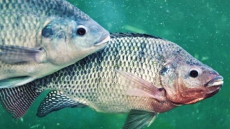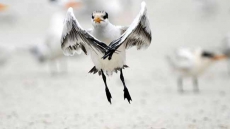SCOTTSDALE, Ariz. - The enormous fan-like propeller behind the passenger whirs, then begins to howl as the pilot hits the accelerator.
The wheels bump along the gravelly desert and a small jolt tugs on the safety belts as the chute billows into the sky.
A few seconds later, the strange-looking machine lifts off the ground, floating away like a dandelion spore catching the wind.
The takeoff of a powerchute is quick, exhilarating, unlike anything you've ever experienced.
The actual flight, even better.
"It's the closest thing to being a bird that you can imagine," said Randy Long of Arizona Powerchutes.
OK, we know what you're thinking now: What's a powerchute?
Picture a dune buggy with a massive parachute attached to the back of it, sort of a cross between something the Wright Brothers might have designed and that flying machine from the Mad Max movies.
The front end looks a little like a three-wheeled stroller, the seats set atop an angled frame behind a fat rubber wheel. The two back wheels splay out for support under the engine and a massive propeller that looks a little like an oversize house fan behind the passenger.
Brackets rise up and out to the sides to support the lines that attach to the chute, which is essentially a 40-foot version of what skydivers use. Turning is controlled by foot levers that pull on the tension cords attached to the chute.
Yes, it's a little odd-looking.
And, yes, it provides a flying experience unlike any other.
"I had been on a balloon tour before and it reminds me of that in some ways with the setup and you're out there at sunrise," said Laura McMurchie of Scottsdale. "But once you're in the air, it's a little more liberating than being in the balloon with 10 other people. It's just you and the pilot and they do everything from skimming, where you're low to the ground and skimming the terrain basically, and then they go up quite high in that contraption."
Powerchutes — short for powered parachutes — are similar to powergliders in that both are small-engine flying machines.
The difference is that powerchutes allow passengers and require a sport pilot license to operate. Powergliders either have a motor that attaches as a backpack or has a small buggy that goes with it, while powerchutes are larger with more powerful engines and bigger chutes.
Powerchutes have a range of about 50 miles — Long's engine uses a 10-gallon fuel tank — and top out at around 28 mph. The machines can fly up to 10,000 feet and, unlike most aircraft, are allowed under FAA rules to fly down to the surface in uninhabited areas.
They're also considered one of the safest aircraft around because of their stability and, as Long puts it, the safety equipment (the chute) is already deployed before it leaves the ground.
"It seems like it's a little bit of this makeshift device, but it works," McMurchie said.
The range of altitude and the relatively slow speeds of powerchutes provide an exhilarating flying experience, from soaring up high for spectacular views to darting along washes and riverbeds from just above the treetops.
Powerchutes are a fantastic way to view wildlife from above — though the coyotes don't like the engine noise too much.
Law enforcement agencies also have used powerchutes in search and rescue efforts because the machines move slower and get to more places than regular aircraft.
And because the machines don't need much space to get airborne, pilots can take off from backyard strips, small airports or even open fields.
"If you're a pilot of a small plane, you fly from one small airport with your buddies, eat breakfast and fly back," Long said. "But these give you a little more sense of adventure, getting out and enjoying nature, have a little wind in your face and maybe see some wildlife."
Powerchutes are flown all over the country but tend to be more popular in places with warmer climates.
Long has flown hot-air balloons for about 30 years and is the only FAA-certified instructor in Arizona.
Arizona Powerchutes, which also offers hot balloon rides, has a 30-minute introductory flight for $289 per person, and has training packages available.
Stay-and-fly packages also are available with the Four Seasons Resort Scottsdale at Troon North, where guests can add to their connect-with-the-sky experience with a Celestial Picnic under the stars the night before.






